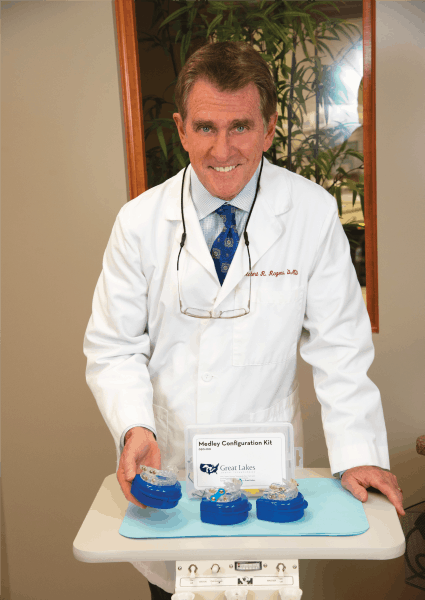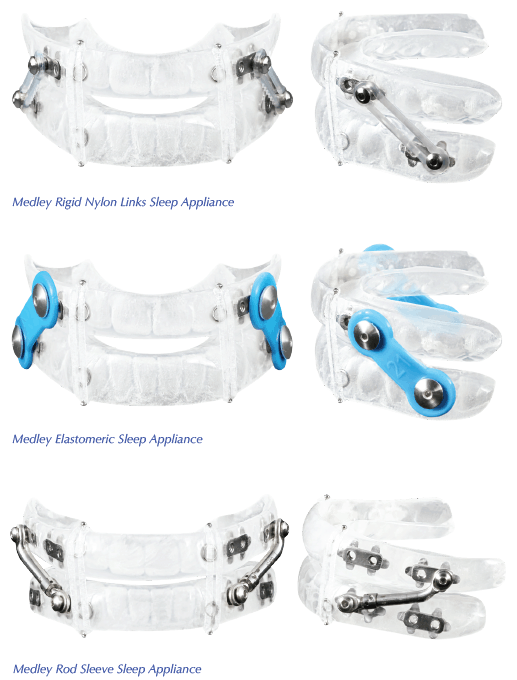by Robert R. Rogers, DMD, D.ABDSM
 My first experience with a sleep appliance was in 1990 when I journeyed from Pittsburgh to San Antonio to hear the late Dr. Thomas Meade speak about his breakthrough boil and bite Snore Guard appliance. My success with this rudimentary method of stabilizing the mandible during sleep changed the course of my career and the lives of thousands of patients. Over time, the concept proved valid and the appliances became customized and more sophisticated. Today, there are more than 150 designs from which we may choose.
My first experience with a sleep appliance was in 1990 when I journeyed from Pittsburgh to San Antonio to hear the late Dr. Thomas Meade speak about his breakthrough boil and bite Snore Guard appliance. My success with this rudimentary method of stabilizing the mandible during sleep changed the course of my career and the lives of thousands of patients. Over time, the concept proved valid and the appliances became customized and more sophisticated. Today, there are more than 150 designs from which we may choose.
The concept of mandibular stabilization remains rather constant while the application of varying hardware designs to accomplish this has proliferated. Even so, there are only a few variations of the basic theme. Very early on, as appliances began to offer protrusive adjustability, the Herbst rod/sleeve design was observed to be effective and continues to enjoy great popularity today. Eventually, orthodontic expansion screws were utilized in various ways to advance the mandible. At the same time, anterior hooks, rigid and elastomeric straps were effectively utilized. Recently, wings or fins are effectively employed to accomplish our purpose.
A common question from novice practitioners is, “What appliance design should I utilize?” Indeed, seasoned veterans are also concerned with which appliance design matches the needs of different patients. Further complicating matters, Medicare and other insurance carriers dictate the use of certain designs and prohibit the use of others. Personally, I am approaching 30 years practicing dental sleep medicine and have fabricated over 10,000 appliances. I have “been around the track” as they say and have utilized most of the designs available today. I have experienced great success with many of them and at the same time have had more than my share of frustrations.
Over time it became apparent to me that no single appliance design is effective for every patient. Anatomic considerations and patient response varied significantly from case to case and became confounding factors to the routine use of my “favorite” appliance. Experienced dental sleep medicine practitioners now understand that some patients accommodate and respond better to certain appliance designs over others and it is necessary to ultimately fit the patient with the most comfortable, effective appliance possible. With this reality in mind, I sat down with some design engineers and created a “universal” appliance that offers three different design features on the same platform. Hence, the name Medley. In less than a minute, the Medley appliance (FDA cleared and Medicare PDAC approved) can transform from a rigid nylon link, similar to a Narval or Panthera, to an elastomeric strap in the style of the EMA appliance. And in another minute can take advantage of the Herbst rod/sleeve mechanism if indicated.
The variable Medley design offers dentists and patients a quick, easy, and economical way to utilize 3 different oral appliance designs without having to incur additional lab expense or waste valuable treatment time. Each of the 3 different design applications is quickly interchangeable on the same appliance platform at chairside by the dentist or assistant in less than a minute.

The 3 different designs are predicated on well-known, commonly used advancement mechanisms that have been in use for years. The breakthrough represented by the Medley appliance is the interchangeability of these 3 protrusive mechanisms.
- The rigid nylon link application employs a mandibular “pulling” force which provides a rigid, firm advancement feel and will not deform with prolonged use. Six different lengths are available for jaw advancement and by simple movement of an anchor screw can offer another 6 advancement positions for a total of 12 mm of protrusion. In my practice, this has proven to be a very effective and comfortable approach with over 2,000 appliances delivered.
- The elastomeric strap application similarly employs a “pulling” force but offers a softer feel to the patient. I find this most effective for certain patients who may have tender temporomandibular joints, slightly mobile teeth, or simply prefer the softer feel. The slight stretch of the elastomeric straps acts as a shock absorber and can be used temporarily to settle down a hot joint or be used permanently if desired. Unlike other elastomeric strap designs, the attachment screws will not dislodge from the platform and are much easier to place and remove.
- The Herbst rod/sleeve application employs a “pushing” force, delivers firm jaw positioning, and is accepted by Medicare PDAC and other insurers who follow Medicare guidelines.
Great Lakes Dental Technologies is the exclusive distributor of the Medley appliance. The interchangeable protrusive mechanisms can be placed on any base material platform that Great Lakes offers such as Durasoft bi-laminate, Biocryl with Thermacryl, or hard acrylic. Ball clasps can be included for retention if desired.
A demonstration video is available on the Great Lakes Dental Technologies website: http://MedleySleepAppliance.com.
Case Study #1
Bill W., 58 years old with a history of Parkinson’s disease, had been a 5 year user of a traditional Herbst appliance originally made by another dentist. He came to our office requesting a new appliance of the same design, and we fabricated a Medley utilizing the Herbst rod/sleeve mechanism. As he titrated the appliance over several weeks to manage his subjective symptoms, he mentioned that the adjusting mechanism was becoming more difficult for him due to his advancing condition. We demonstrated the rigid nylon link mechanism and he felt that it would suit his particular circumstance better. In less than a minute, my assistant transformed the original Herbst rod/sleeve mechanism to the nylon link, and he has accommodated well to the easy placement and removal of the links.
Case Study #2
Margaret L., 38 years old, was initially placed in a Medley nylon link application. Within 10 days, her subjective symptomatology was improved significantly. However, she complained of bilateral TMJ tenderness that lasted throughout the day. She had no history of TMD and the appliance fit well, had good midline relation, and reasonable vertical dimension. Her dental intercuspation was unaltered. We asked her to cease using the appliance for a few days until the sensitivity resolved and then resume use. She did so, but the joint tenderness recurred in several days. At this juncture the rigid nylon links were replaced with the elastomeric straps by the assistant. After several days of use, the joint tenderness resolved and did not return. At her 6-month evaluation visit, she asked if the nylon links could be put back on, since the elastomeric straps had to be replaced every several weeks due to stretching. The assistant then replaced the straps with the nylon links for a trial with the understanding that we could easily return to the elastomeric straps as needed. As is generally the case in my experience, she then accommodated well to the nylon links.
 Parts Management
Parts Management
Since the Medley offers three variations of protrusive mechanisms, there are a few different parts that need to be coordinated. Great Lakes offers a very handy Medley Configuration Kit to help keep track of the screws, links, straps and rod/sleeve arms. The kit is a one-time purchase and affords the dentist an easy way to manage parts inventory so that protrusive mechanisms can be quickly interchanged as needed or replaced if damaged.
Platform Configuration
Two platform configurations are available. The “Complete” Platform has attachment locations to accept all 3 design variations previously discussed. It can accommodate the nylon link, elastomeric strap, and the Herbst rod/sleeve arms.
For cases where the dentist is certain that the Herbst rod/sleeve arms are not needed, the “Basic” Platform can be ordered. It features attachment locations for the nylon link and elastomeric strap applications only and carries a lesser lab fee.
The Great Lakes Dental Technologies website has a comprehensive video tutorial on Medley construction and utilization: http://MedleySleepAppliance.com.

